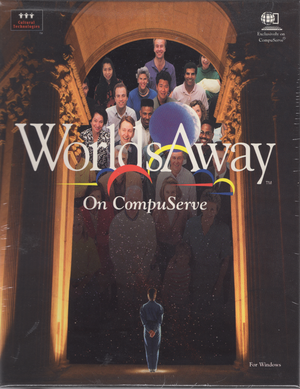WorldsAway
| Developer(s): | Fujitsu Cultural Technologies Division of Fujitsu Open Systems Solutions, Inc. (FOSSI) and Fujitsu Limited |
|---|---|
| Publisher(s): | Fujitsu Cultural Technologies |
| Director(s): | TBA |
| Producer(s): | Randy Farmer, Jeffery Douglas |
| Designer(s): | Randy Farmer |
| Platform(s): | Windows, Mac |
| Released: | (Beta): August 1995, (Launched): November 1995 |
Preface
This article is a work in progress. Some more information is available on the Talk page, but bear in mind it's unorganized and possibly missing citations.
Origins
In early 1993, Fujitsu had shown interest in bringing Fujitsu Habitat to the west. The initial codename for the project was "Habitat/USA". In order to happen, LucasArts (formerly Lucasfilm Games) had to be bought out of their ownership of the Habitat intellectual property.
The plan was to backport the Fujitsu Habitat PC-9801 software to Windows computers, create 256 color artwork and replace the original 16 color artwork and leverage the existing architecture. The theory behind this was that it would be cheaper to port and extend what was already there rather than create something brand new. However, the server source code for Fujitsu Habitat revealed major architectural problems[1].
At some point early on during the initial development stage, John Onusko who wrote the majority of the WorldsAway server code had been analyzing the Fujitsu Habitat server sources that the Japanese team had sent over. John made a comment to Randy Farmer along the lines of "you know the game runs in the server, right?". This was in reference to the fact that the Fujitsu Habitat client acted more like a terminal viewing program and all of the actual processing occurred on the server. Randy later said that he knew the entire project had to be started from scratch that very same day[2].
It was instead decided that development efforts would be better focused on writing something new from the ground up. This was when the codename of the project became Reno.
The Fujitsu Habitat source code that was sent to Electric Communities by Fujitsu shows dates of August 1993 being the time the project had started to backport the software.
In 1994, Electric Communities was contracted by Fujitsu to build WorldsAway[3].
Development
Placeholder.
The original WorldsAway development team as taken from the Reno Team "First Look" image in May of 1994 is as follows:
Tony Christopher, Motoo Chiya, Jeanette Rosado, Dana Timbrook, Kevin Oltendorf, Bob Schumaker, Ed Hodapp , Perry Tucker, John Onusko, Norman Morse, Alex Griffiths, Maria Douglas, Eric Miller, Paul Willis, Joyce Harada , Paul Taylor, Mary Seabrook, Sophie Kim, Randy Farmer, Chip Morningstar, Yoshi Matsumoto and Alicia McCurdy
Regarding this image, Norman Morse is quoted as saying this:
It was a photoshopped image which was presented to all the team members, to celebrate the first internal release of Fujitsu WorldsAway. The names of the dev team members were included, and their head pictures attached to avatar bodies. This was created before DreamScape was released, so we were mostly developers and support staff, we didn't have oracles and community staff until later.
The WorldsAway 1.0 development team as taken from the 1.0 client is as follows:
Fred Atton, Diane Bancroft, Carol Lyn Bowman, Hunter Brown, Motoo Chiya, Anthony Christopher, George Chiu, Jeff Crilly, Mike DeNicola, Clark Dodsworth, Jeff Douglas, Wendy DuBois, Mike Elola, Christopher Flake, Kazutomo Fukuda, Melanie Gendron, Alex Griffiths, Joyce Harada, Carolly Hauksdottir, Tom Hayes - Big Sound, Edward Hodapp, Naohisa Kawaguchi, Rena Keslar, Andrew Keim, Sheryl Knowles, Sophie Kim, Sean Kunkel, Lou Leonardo, Ron Lichty, Lambert Ma, Mary Madaras, Karen Mangum, Jason Mathews, Mark Mathews, Kazuki Matsui, Alicia McCurdy, Garth Minette, Scott Moore, Norman Morse, Bob Moss, Charlotte Nader, Sean O'Brien, Kevin Oltendorf, John Onusko, Amy Or, Kazuhiro Ouchi, Christopher Parry, David Peterson, Janet Richardson, Judith Rubin, Robert Schumaker, Mary Seabrook, Carmen Segovia, Tammy Sims, Chris Simmons, Larry Shelley, Greg Specht, Sharon Stambaugh, Eddy Sumardy, Tadayuki Tahara, Paul Taylor, Dana Timbrook, Michael Torgersen, Satoshi Tsuchiya, Vaserius the Wise, Karen Williams, Paul Willis, Judy Wilson, Rick Wong, Manabu Yanagida, Cathy Yih, and Joe Zona Special recognition to: Randy Farmer and Chip Morningstar whose cyberspace expertise was the foundation of our technology and world design. Maria Douglas for the Dreamscape story and World design direction. Yoshi Matsumoto who carried the WorldsAway flame from Tokyo to California and continues to fuel it today.
Localized Versions
Placeholder for Habitat II and Glass City.
References
- ^ Habitat Chronicles article "You can't tell people anything" - April 2004, http://habitatchronicles.com/2004/04/you-cant-tell-people-anything/
- ^ E-mail conversations with Chip Morningstar and Randy Farmer - 4/01/2025
- ^ Electric Communities WorldsAway info page - May 1998, https://web.archive.org/web/19980520232826/http://www.communities.com/company/background/projects/worlds/index.html
